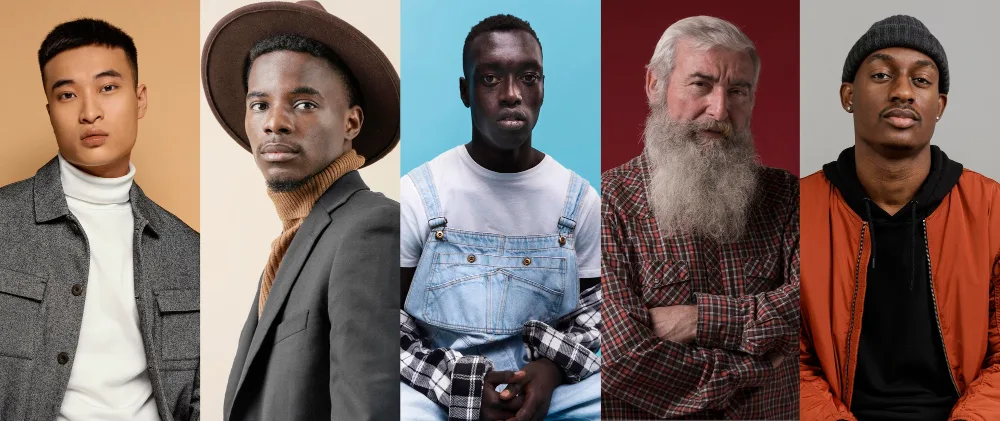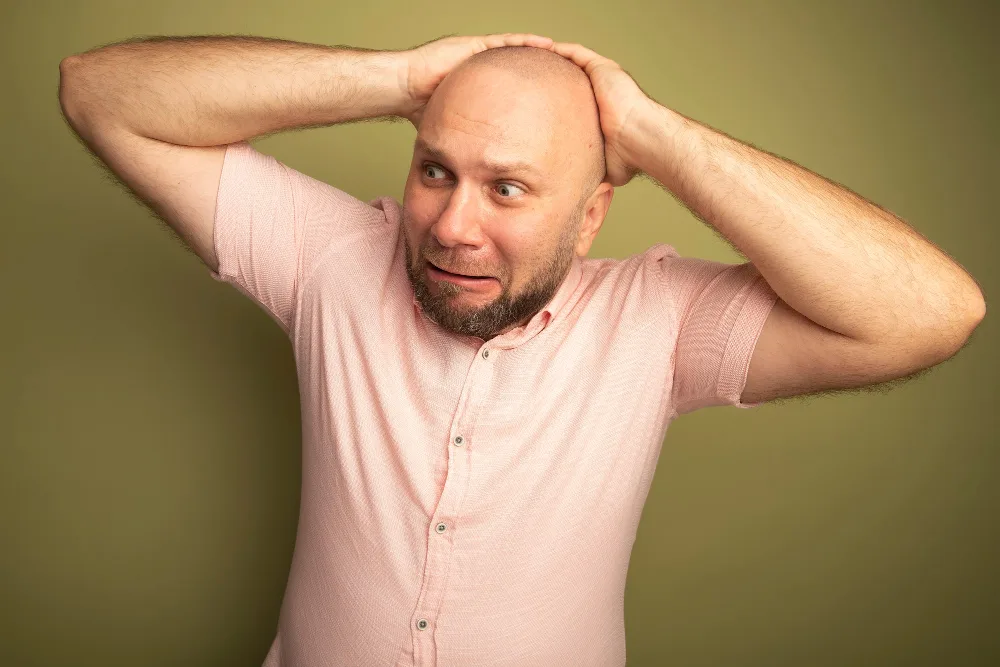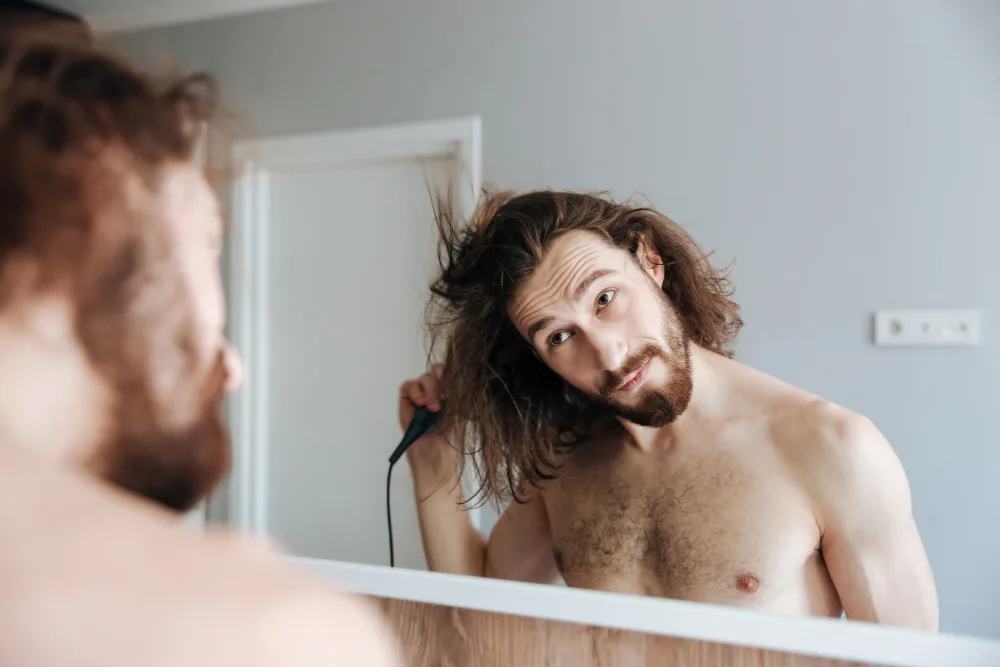Introduction
Let’s be honest—most of us guys spent years grabbing whatever 2-in-1 shampoo was on sale and calling it a “hair care routine.” I was that guy too. But I’ve learned that taking care of your hair isn’t just about looking good (though that’s definitely a perk). It’s about confidence, health, and honestly, making the most of what you’ve got—whether that’s a full head of thick hair or working with thinning spots.
The world of men’s hair care has evolved dramatically in recent years. Gone are the days when “men’s grooming” meant a quick rinse with whatever soap was in the shower. Today, there’s a whole ecosystem of products designed specifically for men’s unique hair needs—from specialized shampoos to styling products that offer both hold and hair health benefits.
In this guide, I’ll walk you through everything you need to know about men’s hair care—from building a basic routine to solving common hair problems. Whether you’re dealing with thinning hair, an oily scalp, or just want to step up your styling game, I’ve got you covered. Let’s dive in.
10 Essential Elements of Men’s Hair Care
1. Understanding Your Hair Type
Before you can properly care for your hair, you need to know what you’re working with. Is your hair straight, wavy, curly, or coily? Is it fine, medium, or thick? Is your scalp dry, oily, or somewhere in between?
Your hair type determines everything from which products will work best to how often you should wash your hair. Here’s a quick breakdown:
Straight Hair: Tends to get oily faster as natural oils travel down the shaft easily. Typically needs more frequent washing but less intensive moisturizing.
Wavy Hair: Often has a mix of needs—can get oily at the roots but dry at the ends. Benefits from balanced products that don’t weigh hair down.
Curly Hair: Usually drier as natural oils don’t travel down the hair shaft as easily. Requires more moisture and less frequent washing.
Coily Hair: Typically the driest hair type, needing intense moisture and very minimal washing.

Take a minute to assess your hair in its natural state. This self-knowledge will guide every other hair care decision you make.
2. Choosing the Right Shampoo
One of the most common questions I get is, “What’s the best shampoo for men?” The answer isn’t one-size-fits-all—it depends entirely on your hair type and concerns.
Here’s what to look for based on common hair issues:
For Oily Hair: Look for clarifying shampoos that remove excess oil without stripping the hair completely. Ingredients like tea tree oil or citrus extracts can help balance sebum production.
For Dry Hair: Choose moisturizing shampoos with ingredients like shea butter, argan oil, or glycerin. Avoid products with sulfates, which can be overly drying.
For Thinning Hair: Opt for volumizing formulas that don’t weigh hair down. Look for ingredients like biotin, niacin, and proteins that strengthen the hair shaft.
For Dandruff: Select anti-dandruff shampoos with active ingredients like zinc pyrithione, ketoconazole, or salicylic acid to address flaking and itching.
Among green, chemical-free options, the Brickell Men’s Daily Strengthening Shampoo stands out. With tea tree oil and peppermint, it cleanses effectively while strengthening hair—perfect for guys who want performance without harsh chemicals.

3. The Art of Conditioning
If you’re still skipping conditioner, you’re missing a crucial step. Conditioner isn’t just for people with long hair—it’s essential for hair health at any length.
Here’s why: Shampoo opens the hair cuticle to clean it, while conditioner seals it back up, locking in moisture and protecting your hair from damage. Without conditioner, your hair remains vulnerable.
For shorter styles, you don’t need much—a dime-sized amount worked through your hair for 1-2 minutes is sufficient. For longer styles, focus conditioner mainly on the mid-lengths and ends, which are older and more prone to damage.
Scotch Porter Moisturizing Beard & Hair Conditioner offers excellent hydration with biotin and shea butter, making it a versatile option for both hair and facial hair.
4. Washing Frequency: Finding Your Sweet Spot

How often should men wash their hair? This is probably the most debated question in hair care, and for good reason—there’s no universal answer.
Overwashing can strip your hair of natural oils, leading to dryness and irritation. Underwashing can lead to buildup, itchiness, and odor. Your ideal washing schedule depends on several factors:
Hair Type: Generally, straight and fine hair needs more frequent washing (every 1-2 days), while curly and coarse hair can go longer between washes (every 3-7 days).
Scalp Condition: Oily scalps may need more frequent washing, while dry scalps benefit from fewer washes.
Activity Level: If you work out daily or have a job that exposes you to dirt or environmental pollutants, you may need to wash more frequently.
Product Usage: Heavy styling product users typically need to wash more often to prevent buildup.
My recommendation? Start with washing every other day and adjust based on how your hair responds. Many guys find that their scalp adjusts over time, producing less oil when not stripped daily by shampoo.
On non-wash days, you can still rinse with water and use a bit of conditioner on the ends if needed (known as “co-washing”).
5. Scalp Care: The Foundation of Healthy Hair
Think of your scalp as the soil in which your hair grows—if it’s not healthy, your hair won’t be either. Yet scalp care is often overlooked in men’s grooming routines.
Here’s how to maintain a healthy scalp:
Regular Exfoliation: Just like your face, your scalp benefits from occasional exfoliation to remove dead skin cells and product buildup. Try a scalp scrub once a week or a shampoo with gentle exfoliating ingredients.
Massage: Scalp massage increases blood flow to hair follicles, which can promote healthier hair growth. Take an extra minute during shampooing to massage your scalp with your fingertips (not your nails).
Hydration: A dry scalp can lead to flaking and discomfort. If you’re prone to dryness, look for hydrating scalp treatments or oils that won’t weigh your hair down.
The John Masters Organics Spearmint & Meadowsweet Scalp Stimulating Shampoo is excellent for scalp health, using organic ingredients to stimulate circulation and remove buildup without harsh chemicals.
6. Dealing with Hair Loss

Let’s talk about what’s on many men’s minds: hair loss. About two-thirds of American men will experience some degree of appreciable hair loss by age 35, so you’re definitely not alone if you’re seeing more of your scalp than you used to.
While there’s no miracle cure for baldness, there are effective ways to slow hair loss and maintain the hair you have:
- Understand the Cause: Male pattern baldness (androgenetic alopecia) is the most common cause, but stress, nutritional deficiencies, certain medications, and health conditions can also cause hair loss. If your hair loss is sudden or accompanied by other symptoms, consult a doctor.
- Over-the-Counter Options: Ingredients like minoxidil (the active ingredient in Rogaine) have been clinically proven to slow hair loss and sometimes regrow hair for many men when used consistently.
- Prescription Options: Medications like finasteride (Propecia) work by blocking DHT, the hormone responsible for male pattern baldness. These require a doctor’s prescription and can have side effects.
- Natural Approaches: Some natural ingredients like saw palmetto, pumpkin seed oil, and rosemary oil show promise in research for hair loss, though results are typically more modest than with medications.
Most importantly, start treatment early—it’s much easier to keep the hair you have than to regrow what’s lost.
7. Styling Products: Choosing What Works for You
The world of men’s styling products can be overwhelming—pomades, waxes, clays, gels, pastes, creams…how do you know what’s right for you?
Here’s a simplified breakdown:
- Pomade: Provides a slick, often shiny finish. Great for classic, structured styles like side parts and pompadours. Available in water-based (easier to wash out) and oil-based (stronger hold) varieties.
- Clay: Offers a matte finish with texture and volume. Ideal for messier, textured styles and works well with most hair types.
- Wax: Provides strong hold with some shine. Good for shorter styles that need definition.
- Cream: Gives light hold with natural shine. Perfect for longer styles and curly hair that needs moisture and light control without stiffness.
- Gel: Offers strong hold with high shine. Best for very structured styles that need to stay in place all day.
- Sea Salt Spray: Creates texture and volume with minimal hold. Great for casual, beach-inspired looks.
For a natural option, Hanz de Fuko Natural Shampoo pairs well with their styling products, which use organic ingredients to provide hold without harmful chemicals.
8. Heat Styling: Minimizing Damage
While not all men use heat styling tools, those with longer styles often rely on blow dryers, straighteners, or curling irons. Here’s how to minimize the damage:
- Always Use Heat Protection: Apply a heat protectant spray or cream before using any hot tools.
- Lower the Temperature: You rarely need the highest heat setting—start low and increase only if necessary.
- Don’t Style Wet Hair: Hair is most vulnerable when wet. Let it air dry at least 50% before applying heat.
- Limit Frequency: Try to incorporate heat-free days into your routine to give your hair a break.
For added protection, consider Heat protection sprays for men’s hair that shield strands from temperatures up to 450°F while adding shine and reducing frizz.
9. Haircuts and Maintenance
Even the best hair care routine can’t compensate for a bad haircut. Here’s how to make the most of your salon or barbershop visits:
- Know Your Face Shape: Different styles complement different face shapes. A good barber can help you determine what works best for your features.
- Communicate Clearly: Bring reference photos when possible, and be specific about what you want—including how much maintenance you’re willing to do daily.
- Regular Trims: Even if you’re growing your hair out, regular trims (every 4-6 weeks) help prevent split ends and keep your style looking intentional.
- Learn Basic Upkeep: Ask your barber to show you how to maintain your style at home with the right products and techniques.
10. Nutrition and Lifestyle Factors
Finally, remember that healthy hair starts from within. Your diet and lifestyle dramatically impact your hair’s appearance and growth:
- Stay Hydrated: Dehydration can make hair brittle and dull.
- Eat a Balanced Diet: Hair is made of protein, so ensure you’re getting enough in your diet. Also important are omega-3 fatty acids, vitamins A, C, D, E, and minerals like zinc and iron.
- Manage Stress: Chronic stress can contribute to hair loss and scalp problems. Regular exercise, adequate sleep, and stress management techniques can all benefit your hair.
- Limit Harmful Habits: Smoking and excessive alcohol consumption can contribute to hair damage and loss.
A daily multivitamin can help fill nutritional gaps, but whole foods are always the best source of hair-healthy nutrients.
Frequently Asked Questions About Men’s Hair Care
What are the best shampoos for men’s hair care?
The best shampoo depends entirely on your hair type and concerns.
For all-around performance with natural ingredients, Brickell Men’s Daily Strengthening Shampoo and Aveda Men Pure-Formance Shampoo consistently receive top ratings. For thinning hair, Jack Black True Volume Thickening Shampoo offers excellent results without harsh chemicals. Those with dry hair should consider Shea Moisture Men Maracuja Oil & Shea Butter Shampoo for deep nourishment.
How often should men wash their hair?
Most men do best washing their hair 2-3 times per week, but this varies based on hair type, scalp condition, activity level, and styling product usage. Fine, straight hair typically needs more frequent washing (every 1-2 days), while curly and coarse hair can often go 3-7 days between washes. Listen to your hair—if it feels greasy or itchy, it’s time to wash; if it feels dry or brittle, you might be overwashing.
What are the top tips for preventing hair loss in men?
To prevent hair loss: 1) Start treatment early at the first signs of thinning, 2) Consider proven ingredients like minoxidil or finasteride (consult a doctor first), 3) Be gentle with your hair—avoid tight hairstyles and rough brushing, 4) Maintain a healthy diet rich in protein and essential nutrients, 5) Manage stress through exercise and mindfulness, 6) Get regular checkups to rule out underlying health conditions that might cause hair loss, and 7) Consider natural DHT blockers like saw palmetto as a supplement to other treatments.
Which products work best for styling men’s curly hair?
Curly hair thrives with moisturizing, alcohol-free products that enhance natural texture without causing frizz. Scotch Porter Moisturizing Beard & Hair Conditioner provides excellent hydration. For styling, cream-based products like Shea Moisture Men Maracuja Oil & Shea Butter Shampoo work well. Avoid heavy waxes or gels that can weigh curls down and cause crunchiness. Leave-in conditioners are excellent for maintaining moisture throughout the day.
How can men maintain a healthy scalp?
For a healthy scalp: 1) Don’t overwash—this can strip natural oils and cause irritation, 2) Exfoliate weekly with a dedicated scalp scrub to remove buildup, 3) Massage your scalp when shampooing to increase blood flow, 4) Stay hydrated and maintain a balanced diet rich in zinc, B vitamins, and omega-3s, 5) Protect your scalp from sun damage with hats or SPF products, and 6) Consider John Masters Organics Spearmint & Meadowsweet Scalp Stimulating Shampoo for regular maintenance.
What are the benefits of using sulfate-free shampoos for men?
Sulfate-free shampoos offer numerous benefits: 1) They clean without stripping natural oils, preventing dryness and irritation, 2) They’re gentler on color-treated hair, helping maintain vibrancy longer, 3) They cause less frizz and flyaways, especially for curly or textured hair, 4) They’re less likely to cause scalp irritation for sensitive skin, and 5) They’re typically more environmentally friendly. R+Co Television Perfect Hair Shampoo provides excellent cleansing without sulfates.
What is the ideal hair care routine for men with dry hair?
For dry hair: 1) Limit washing to 1-2 times weekly, using a sulfate-free, moisturizing shampoo like Kiehl’s Nourishing Olive Fruit Oil Shampoo, 2) Always use a rich conditioner, leaving it on for 3-5 minutes before rinsing, 3) Apply a leave-in conditioner or hair oil to damp hair after washing, 4) Avoid heat styling or use low heat with protection, 5) Sleep on a silk or satin pillowcase to reduce friction, and 6) Deep condition weekly with a hydrating hair mask.
How can men protect their hair from heat damage?
To protect hair from heat: 1) Always use a dedicated heat protectant product before blow-drying or using hot tools, 2) Let hair air dry at least 50% before applying heat, 3) Use the lowest effective heat setting on tools, 4) Invest in high-quality tools with temperature control, 5) Don’t use hot tools daily—alternate with heat-free styles, 6) Deep condition weekly to restore moisture, and 7) Get regular trims to remove damaged ends before they travel up the hair shaft.
Are natural or organic hair care products better for men’s hair?
Natural products can offer significant benefits—fewer irritants, environmental sustainability, and gentler cleansing—but “natural” doesn’t automatically mean “better.” The key is finding products that work for your specific hair type and concerns, whether natural or conventional. That said, many men find that natural options like Ursa Major Go Easy Daily Shampoo and Christophe Robin Hydrating Shampoo Bar provide excellent results without potentially problematic ingredients like parabens, phthalates, and synthetic fragrances.
What are the best ways to manage frizzy hair for men?
To manage frizz: 1) Wash with sulfate-free shampoo like Briogeo Be Gentle, Be Kind Aloe + Oat Milk Shampoo, 2) Use a microfiber towel to gently blot (never rub) hair, 3) Apply an anti-frizz product to damp hair—look for ingredients like argan oil or dimethicone, 4) Let hair air dry whenever possible or use a diffuser attachment on low heat, 5) Avoid touching your hair throughout the day, as this stimulates frizz, 6) Consider a weekly deep conditioning treatment, and 7) In humid weather, use stronger hold products to keep hair in place.
Hair Care by Hair Type: Quick Reference Guide
For Straight Hair
- Wash frequency: Every 1-2 days
- Recommended products: Lightweight volumizing shampoos, light hold styling products
- Common challenges: Oiliness, lack of volume
- Top product pick: Jack Black True Volume Thickening Shampoo
For Wavy Hair
- Wash frequency: Every 2-3 days
- Recommended products: Balancing shampoos, texturizing sprays, light creams
- Common challenges: Inconsistent wave pattern, frizz
- Top product pick: R+Co Television Perfect Hair Shampoo
For Curly Hair
- Wash frequency: Every 3-4 days
- Recommended products: Moisturizing sulfate-free shampoos, leave-in conditioners, curl creams
- Common challenges: Dryness, frizz, definition
- Top product pick: Shea Moisture Men Maracuja Oil & Shea Butter Shampoo
For Coily/Kinky Hair
- Wash frequency: Every 5-7 days
- Recommended products: Deep moisturizing cleansers, heavy conditioners, butters and oils
- Common challenges: Extreme dryness, shrinkage, breakage
- Top product pick: Scotch Porter Moisturizing Beard & Hair Conditioner
DIY Hair Treatments for Common Problems
Sometimes the best hair solutions are found right in your kitchen. Here are some effective DIY treatments for common hair concerns:
For Dry Hair and Scalp
Avocado and Olive Oil Mask
- Mash 1/2 ripe avocado
- Mix with 2 tablespoons olive oil
- Apply to damp hair and scalp
- Leave for 30 minutes, then rinse and shampoo
For Dandruff
Apple Cider Vinegar Rinse
- Mix 1 part apple cider vinegar with 3 parts water
- After shampooing, pour over scalp and hair
- Let sit for 5 minutes, then rinse
- Use weekly as needed
For Hair Growth
Rosemary Scalp Treatment
- Steep 2 tablespoons dried rosemary in 2 cups hot water for 30 minutes
- Strain and cool
- After shampooing, pour over scalp as final rinse
- Don’t rinse out
- Use 2-3 times weekly
For Shine Boost
Beer Rinse
- Open a beer and let it sit until flat
- After shampooing and conditioning, pour over hair
- Rinse with cool water after 5 minutes
- The proteins in beer add strength and shine
Seasonal Hair Care Tips for Men

Summer
- Use lighter products that won’t melt in heat
- Consider UV protection for hair and scalp
- Rinse hair after swimming in pools or salt water
- Hydrate more to prevent dry hair from the inside out
Fall
- Restore moisture lost during summer with regular conditioning treatments
- Address any sun damage with protein treatments
- Prepare for static electricity as the air gets drier
Winter
- Switch to more moisturizing shampoos and conditioners
- Use leave-in conditioners more frequently
- Wear hats for protection but choose breathable fabrics
- Humidify your living space to prevent indoor dryness
Spring
- Clarify to remove product buildup from heavier winter products
- Get a fresh cut to remove winter damage
- Gradually lighten your product routine as humidity increases
Beyond the Basics: Advanced Hair Care for Men
For those looking to take their hair game to the next level, consider these advanced strategies:
Hair Analysis
Many salons now offer hair analysis services that examine your hair’s porosity, elasticity, and overall health to provide customized recommendations.
Scalp Treatments
Professional scalp treatments can address issues from buildup to circulation problems that affect hair growth.
Hair Supplements
Targeted supplements containing biotin, saw palmetto, vitamin D, and other hair-supporting nutrients can help address deficiencies affecting hair health.
Night Routines
Implementing a nighttime hair care routine—including silk pillowcases, overnight treatments, and protective styling—can significantly improve hair health.

Expert Interview: The Science of Men’s Hair
For additional insights, I spoke with Dr. James Wilson, a dermatologist specializing in men’s hair health. Here are his top insights:
“The biggest mistake men make is using the wrong products for their hair type. Using a heavy oil on fine hair or a drying product on already dry hair can exacerbate problems rather than solve them.”
“Consistency is key—hair care isn’t about finding a miracle product but about establishing a routine that works for your specific needs and sticking with it.”
“Hair health is holistic—factors like sleep quality, stress levels, and nutrition have as much impact as the products you use externally.”
For more expert advice, check out this excellent discussion on men’s hair care fundamentals:
The Psychology of Good Hair: Confidence Matters
It’s not vanity to care about your hair—it’s self-care. Research consistently shows that how we feel about our appearance affects our confidence and how others perceive us. Taking the time to understand and care for your hair is an investment in yourself.
I’ve seen it firsthand—clients who address their hair concerns often report feeling more confident in professional and social settings. Good hair days can genuinely lead to better days overall.
Conclusion: Building Your Personal Hair Care Routine
The world of men’s hair care can seem complex, but it doesn’t have to be overwhelming. Start with understanding your hair type, choose quality products formulated for your specific needs, and establish a consistent routine.
Remember that what works for someone else might not work for you—hair care is personal, and finding your perfect routine may take some experimentation. Be patient with the process and pay attention to how your hair responds to different products and techniques.
Most importantly, healthy hair is a journey, not a destination. As your hair changes with age, seasons, and lifestyle factors, be willing to adapt your approach accordingly.
What hair care challenges are you currently facing? Have you found products or techniques that work particularly well for your hair type? I’d love to hear about your experiences in the comments below.
Ready to upgrade your hair care routine? Start by identifying your hair type and selecting one new product formulated specifically for your needs. Small changes can make a big difference in how your hair looks and feels.




